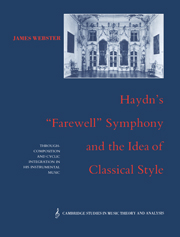 Haydn's 'Farewell' Symphony and the Idea of Classical Style
Haydn's 'Farewell' Symphony and the Idea of Classical Style Historiographical conclusion: Haydn's maturity and “Classical style”
Published online by Cambridge University Press: 28 January 2010
Summary
The high degree of cyclic integration in the Farewell Symphony and other works of Haydn has profound implications for our understanding of his compositional development, his position vis-a-vis Beethoven and the nineteenth century, and “Classical style” itself. It seems appropriate to conclude this study with a discussion of these historiographical topics.
ROSEN'S CRITICISM
Virtually the entire tradition of Haydn scholarship has assumed that he did not attain mastery or maturity (however this concept may be phrased) until the 1770s, in many accounts not until the 1780s. The corollary is that his “early” music – by some definitions more than half his output, up to his fiftieth year – was somehow lacking: in technique, in style, in degree of “synthesis,” in emotional depth, or whatever. So that nobody will suppose that this discussion depends on straw men, I will focus initially on Rosen's The Classical Style which, regarding Haydn's music after c. 1780, offers arguably the most insightful writing in English since Tovey.
But Rosen's attitude towards Haydn's earlier music is highly ambivalent. While not denying its power, expressivity, and originality, he asserts that it lacks rhythmic cogency and large-scale coherence:
Taken on their own terms the works of the late 60s and early 70s inspire admiration; they are defective only when measured by the standards of Haydn's later works … Why then do we impose these standards?
In the twenty years between [J. S. Bach's] death and … the early 70s, [the] language had changed significantly: the syntax was less fluid, the relation between tonic and dominant more highly polarized. Haydn's style of 1770 … was not yet able to embrace its full implications.[…]
- Type
- Chapter
- Information
- Haydn's 'Farewell' Symphony and the Idea of Classical StyleThrough-Composition and Cyclic Integration in his Instrumental Music, pp. 335 - 374Publisher: Cambridge University PressPrint publication year: 1991
- 1
- Cited by


